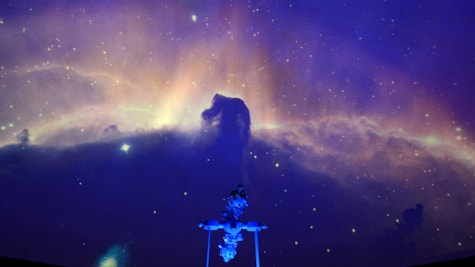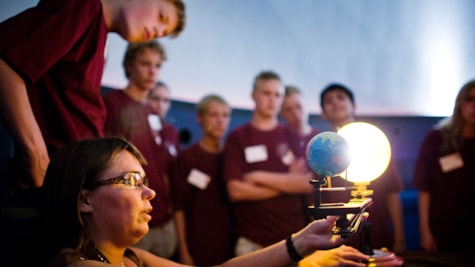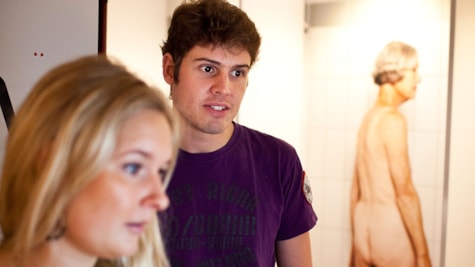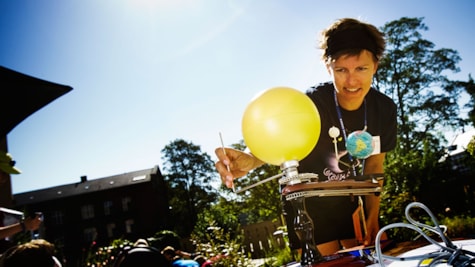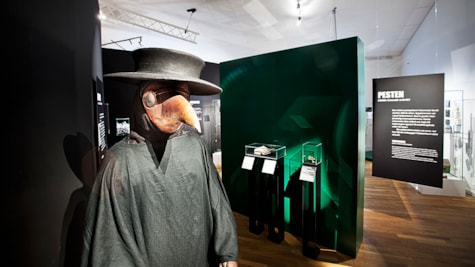Steno Museum
Distance: 10.32 Km
At the Steno Museum you can discover everything from plants to planets and exhibitions about the cultural history of the natural and medical sciences.
Ole Rømer Observatory
The Steno Museum also includes the newly renovated Ole Rømer Observatory in Højbjerg in Aarhus. Here you can experience the beautiful starry sky through Denmark's largest working telescope.
The star shows sell out quickly, so buy your ticket well in advance. Read more about star shows and find tickets here.
Planetarium
In the planetarium you can see notions of galaxies, planets and other exciting celestial phenomena. Sit back in the soft chairs and experience the sky at close quarters as you take a trip out into space.
In the dome ceiling of the planetarium you can see the starry sky of the season, while the guides of the planetarium tell about constellations, distant galaxies and other astronomical phenomena. The Planetarium is a round multimedia room with room for 57 spectators. The ceiling of the hall is a hemisphere 11 meters in diameter.
Full moon evenings
Every month on the evening when it is full moon, you can take part in an atmospheric and exciting experience with a focus on the starry sky of the season. The program changes from time to time, and you can experience stories, hear about astronomy and space research or legends and myths under the constellations. Arrive well in advance, because the doors close after the start time.
The Astrotheque
In the Astroteket at the Steno Museum, space comes under the microscope. Space has always fascinated and shaped man, and the Sun and Moon control the experience of night, day, months and seasons. For a thousand years, the stars have been used to navigate, and the images the stars create have inspired many stories.
Astroteket is a 3D reference work to know more about stars and planets. Get the recipe for a star, understand why there is not always light on the entire Moon, and look for exoplanets about distant stars.
Explore Astroteket and get to know our near and distant neighboring planets and galaxies better.
The medicinal herb garden
In the Steno Museum's herb garden, you can enjoy the sight and smell of the many medicinal herbs. The medicinal herb garden at the Steno Museum is reminiscent of a monastery garden. Here you can find many old and well-known medicinal plants. In the 1800th century, it was discovered to isolate the active substances in the medicinal plants and produce them in laboratories.
Many of the herbs have ingredients that are used in today's medicine. Around 40 percent of the medicines developed in laboratories originate from substances originally found in plants. Enjoy the many scents and colors in the herb garden, or sit on a bench and enjoy the silence or your brought food.
You can also come on a tour of the herb garden. Read more and buy tickets here.
The curious person
In the exhibition The Curious Man, you can learn more about some of the countless discoveries and inventions that have helped shape our modern lives. You can e.g. walk through the many colors of the rainbow in a 7 meter long tunnel, draw with UV light, play with "protons" in a body-sized football game and see how many points and new particles you can kick yourself to.
You can also experience traces of the invisible particles from space that are constantly bombarding us, in the fog chamber of the exhibition. In the exhibition, you can also walk through an authentically reconstructed piece of the 27 km long, underground accelerator tunnel at the CERN research center near Geneva.
Epidemics - a threat to humanity
48 hours. This is how fast you can go from healthy and well to death if you are infected with Ebola. At the Steno Museum's exhibition on epidemics, you can learn more about the six epidemics of plague, smallpox, tuberculosis, polio, AIDS and Ebola.
Become wiser about infection routes and the bacteria and viruses that threaten us. You can also through personal stories get an insight into what the diseases were like for some of those who experienced it on their own body.
Dear body, difficult body
This exhibition is about the body and focuses on the beauty ideals that have prevailed over time, our relationship to nudity and modesty, the latest research in underweight and obesity, and how everyday technology today has replaced the muscle work of the time.
The body as data
In the exhibition "The body as data", space is created for reflection on how we act when we are online. The purpose of the exhibition is for you as a visitor to be more critical of your "online self" and what you share with others via cookies, social media etc.
"The body as data" is part of the exhibition "Dear body, difficult body".
Genetic testing and toothbrushes - How health became common
This exhibition is about how the Danish healthcare system has developed over the past 100 years.
You will have the opportunity to reflect on how health and medical care developed during the 1900s into a national task that offers free prevention and medical care to everyone, that technology has played a decisive role in the development and that several dilemmas have arisen in the development of a healthcare institution.
Experience, among other things wooden X-ray equipment from the first screenings for pulmonary tuberculosis to modern binocular equipment and molecular biology tests.
Science is passion - about research life and boiled crabs
"Science is passion" is about Nobel laureate Jens Christian Skou and life as a researcher. The overall focus is: What drives a researcher? Why spend your life figuring out how cells work or understanding the heart function of certain animals?
The exhibition is framed by five themes which are central to research life:
- Curiosity
- Eksperiment
- Competition and cooperation
- Recognition
- Why research?
As a visitor, you can experiment and try out different things. Experience, among other things "Heart aquarium" with small and large hearts and listen to the resting heart rate of different mammals.
See what others are sharing on Instagram
#stenomouseet #visitaarhus #visitaarhusregion
FREE ACCESS FOR YOUNG PEOPLE UNDER 18 YEARS OLD
Updated by: VisitAarhus | info@visitaarhus.com
